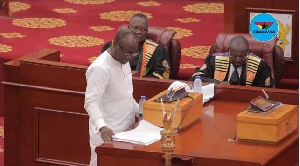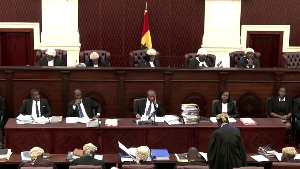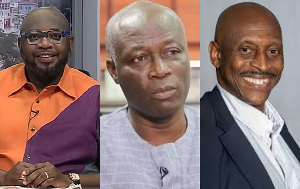Despite an aggressive debt reprofiling efforts, which is said to have saved the country some GH¢600 million, an amount of GH¢14.9 billion (GH¢14,909.8 million) has been provisioned for interest payments in respect of public debts for 2018.
This is equivalent to 6.2% of Gross Domestic Products (GDP), and domestic interest payments constitute about 82% of the amount.
The interest to be paid on Ghana’s debt in 2018 constitutes 24% of the entire budget of GH¢62 billion (GH¢62,010.3 million).
Analysing the data, interest payments is more than twice the GH¢6.8 billion (GH¢6,896.3 million) allocated for capital expenditure.
The capital expenditure provision is equivalent of 2.9% of GDP while interest payments are equivalent of 6.2% of GDP.
Domestically financed capital expenditure is estimated at GH¢3.3 billion (GH¢3,339.1 million), representing 1.4% of GDP.
Government spending has a direct impact on the rate of economic advancement. The need to better the lots of citizens through government expenditure raises questions about capital expenditure that is lower than interest payments.
Government’s budgeted expenditure for the use of goods and services is estimated at GH¢3.5 billion (GH¢3,532.5 million), representing 1.5% of GDP.
Interest payment higher than capital expenditure and goods and services budget combined
The total of capital expenditure and goods and services budget amounts to GH¢10.4 billion (GH¢10,428.8 million), representing 4.4% of GDP.
This demonstrates that the capital expenditure and goods and services budget combined is less than the GH¢14.9 billion, representing 6.2% of GDP, allocated for the payment of interest on Ghana’s loans.
Compensation of employees is GH¢19.5bn
Compensation of employees, which comprises wages and salaries, allowances, pensions, gratuities and social security contributions by government on behalf of its employees, continues to represent the single largest item of government expenditure.
It is estimated at GH¢19.5 billion (GH¢19,595.1 million), representing 8.1% of GDP.
GH¢16.7bn for wages and salaries
Of this amount, GH¢16.7 billion (GH¢16,762.3 million), equivalent to 6.9% of GDP, has been provisioned for wages and salaries alone.
Finance Minister Ken Ofori-Atta explained that because of recent debt reprofiling exercise, the risks associated with payments of maturing shorter-dated domestic debt instruments are being mitigated.
“We are lengthening the maturity profiles of our debt instruments, and this is impacting positively on interest payments.
“As we consolidate our public finances, the annual growth of domestic interest payments is expected to decline considerably,” he said.
GH¢10.9bn overall budget deficit
Based on the estimates for total revenue & grants and total expenditure, the 2018 budget will result in an overall budget deficit of GH¢10.9 billion (GH¢10,971.4 million), equivalent to 4.5% of GDP.
How overall budget deficit will be financed
Financing of the fiscal deficit will be from both domestic and foreign sources. Net foreign financing will amount to GH¢2.9bn (GH¢2,970.8 million), and this includes Eurobond proceeds of GH¢1 billion, equivalent to 1.2% of GDP.
Net domestic financing will constitute about 73% of total financing and includes financing from the bank and non-bank sectors, and other domestic sources.
Therefore, the total net domestic financing is estimated at GH¢8 billion (GH¢8,000.3 million) or 3.3% of GDP.
Primary balance to record surplus of 1.6%
It is worth noting that in 2018, the primary balance, which is an indicative measure of our fiscal sustainability, is estimated to record a larger surplus of 1.6% of GDP from the projected 2017 outturn of 0.2%.
GH¢3.5bn foreign financed capital expenditure
An amount of GH¢3.5 billion (GH¢3,557.2 million) has been budgeted for foreign financed capital expenditure, and this will be funded by a combination of project grants and loans.
One of the challenging economic situations that our government inherited was a ballooning debt stock which placed undue burden on the 2017 budget. Indeed, Ghana’s debt to GDP ratio had increased from 32% in 2008 to 73% by the end of 2016.
This situation resulted in an increasing interest burden, with interest payments alone consuming 45% of tax revenue and 6.8% of GDP in 2016.
Debt-to-GDP ratio drops to 68.3%
However, the debt-to-GDP ratio has declined from 73% at the end of December 2016 to 68.3% as at September 2017.
This is the first time since 2006 that Ghana has witnessed a year-on-year reduction in the debt-to-GDP ratio.
Interest burden reduced
The interest burden of Ghana’s debt has also been reduced. Interest payments have reduced from 45% of tax revenue to 43.8% in September 2017, with a projected 41.9% reduction at the end of 2017.
Ofori-Atta said it was important to note that the annual average rate of debt accumulation of 36% over the last four years has declined over the last nine months to about 13.58%.
This is the lowest annual increase in the public debt over the last decade, he added.
“Our prudent debt management has, therefore, improved the debt outlook and debt sustainability for Ghana.
“We will continue to keep the public debt in check and move purposefully away from the unbridled borrow-and-spend culture of the previous eight years,” he promised.
The debt crisis
A report, jointly published by seven organisations last year, revealed that Ghana is in a debt crisis because the country is losing around 30% of government revenue in external debt payments each year.
It attributed the situation to a combination of the recent fall in the price of commodities and the loans not being used well enough to ensure they could be repaid.
The authors said such huge payments are only possible because Ghana has been able to take on more loans from institutions, such as the International Monetary Fund (IMF), which are used to pay the interest on debts to previous lenders, whilst the overall size of the debt increases.
The situation is expected to stay well above 20% of revenue until, at least, 2035.
GH¢139bn public debt stock
The country’s debt stock reached GH¢139 billion as at the end of June this year, the latest economic and financial data released by the Bank of Ghana (BoG) has revealed.
The data showed that GH¢74.6 billion of the debts were loans secured from outside the country while GH¢64 billion were domestic debts.
Ghana’s debt crisis
It explained that Ghana’s crisis is the result of a gradual increase in lending and borrowing off the back of the discovery of oil and high commodity prices.
“More money was then borrowed following the fall in the price of oil and other commodities since 2013, to try to deal with the impact of the commodity price crash, whilst the relative size of the debt also grew because of the fall in the value of the cedi against the dollar.
“The underlying causes of the return to a debt crisis are, therefore, the continued dependence on commodity exports, as well as borrowing and lending not being responsible enough, meaning that new debts do not generate sufficient revenue to enable them to be repaid,” the report said.
The report is titled ‘The Fall and Rise of Ghana’s Debt: How a New Debt Trap Has Been Set’, and was published this month.
The report was jointly published by the Integrated Social Development Centre Ghana, Jubilee Debt Campaign UK, SEND Ghana, WAZOBA Ghana, All-Afrikan Networking Community Link for International Development, Kilombo Ghana and Abibimman Foundation Ghana.
Jubilee Debt Campaign is part of a global movement demanding freedom from the slavery of unjust debts and a new, financial system that puts people first.
Click to view details



Business News of Saturday, 18 November 2017
Source: thefinderonline.com

















